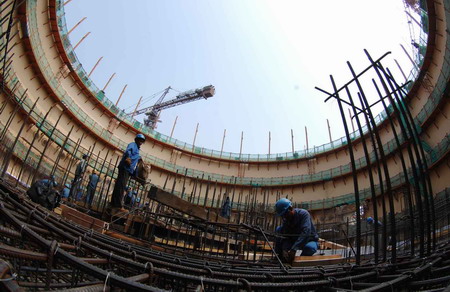Energy
Go slow for nuclear power projects
By Zhou Yan and Li Xiang (China Daily)
Updated: 2011-03-18 09:34
 |
Large Medium Small |
The expansion project at Qinshan Nuclear Power Plant in Zhejiang province. China has stepped up its efforts to develop clean-energy sources, including nuclear power, to meet its target to cut carbon emissions by up to 45 percent for each unit of GDP by 2020. [Photo / China Daily]
Crisis in Japan may force a reduction in the pace of China's construction plans

BEIJING - The nuclear crisis in Japan may slow down China's feverish pace of expansion in the nuclear power sector and is likely to encourage the government to lift standards for newly-built plants, said Ni Weidou, a senior academician of the Chinese Academy of Engineering, on Thursday.
"China's pace of nuclear power development is too fast. I reckon the unfolding nuclear crisis in the neighboring country will slow down our progress in the sector," said Ni, also an adviser of energy strategy for the central government, at a forum in Beijing.
He said the nation will review safety at existing nuclear power plants and may set higher standards for the design of new projects.
Since 2005, the country has approved 13 nuclear power projects with 34 reactor units and a generation capacity of 37.02 million kilowatts, according to the National Energy Administration, and more are in the pipeline.
However, the State Council, China's cabinet, announced on Wednesday that it will halt approval of new nuclear power plants, strengthen investigation of the reactors under construction, and conduct a thorough examination of the existing plants, in the wake of Japan's nuclear meltdown, which was triggered by last week's devastating earthquake and tsunami.
China has stepped up its efforts to develop clean-energy sources, including nuclear power, to meet its target to cut carbon emissions by up to 45 percent for each unit of GDP by 2020.
The country's development strategy for nuclear power during the period of the 12th Five-Year Plan (2011-2015) remains unchanged, despite Japan's ongoing nuclear crisis, said Tian Jinchen, vice-head of the Development Planning Department of the National Development and Reform Commission, the country's top economic planner.
| ||||
China, the world's largest energy consumer, is expected to consume more than 4.5 billion metric tons of standard coal annually by 2020, of which clean energy is expected to account for 15 percent, Ni said.
The country's energy consumption in 2010 totaled 3.25 billion metric tons of standard coal.
China will develop nuclear power safely and reasonably, Tian said.
"China's nuclear reactors have utilized the world's most sophisticated technologies since the country started constructing nuclear power stations, which was much later than Japan; and the electricity generated by nuclear power is relatively small in proportion to total power generation," said Xu Heping, director of Survey and Research Office under the Ministry of Science and Technology.
The country started operating the Qinshan Nuclear Power plant, its first nuclear reactor, in eastern Zhejiang province in 1985. Japan's first commercial nuclear power plant was operational in 1966.
To ensure safety, China should choose coastal areas as locations for the upcoming nuclear power plants because of these geographical stability of these area and their proximity to the sea for a ready supply of water, Ni said.
| 分享按钮 |



